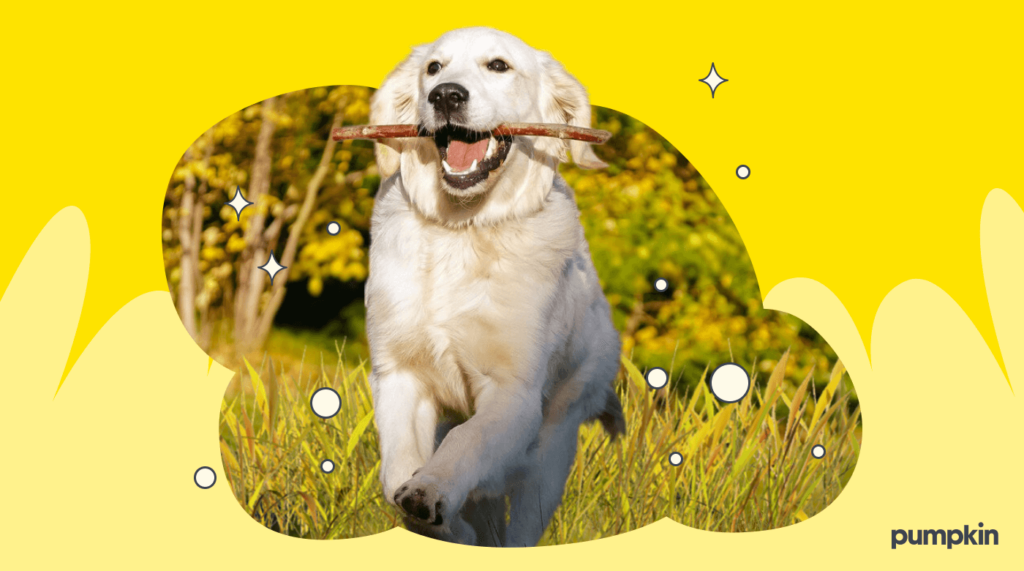Key Points:
- Yes, dogs can have honey in small amounts.
- Honey is packed with antioxidants and can help with allergies in dogs.
- Pure honey is best, so avoid added sweeteners or honey with xylitol, which is toxic to dogs.
There’s nothing quite like honey on toast for breakfast, and the smell alone is enough to get most pups excited, too. But before you toss a piece of that golden goodness to your canine companion, you may be wondering: Can dogs have honey?
In short, real honey is safe for dogs to eat — but that doesn’t mean you should share it with your pup all the time.
Too much of this sugary treat can cause health problems, and non-natural “honey” products can do a lot more harm than good.
So, before you share your favorite honey-sweetened snacks with your dog, read this guide to learn how honey affects our pups.
Nutritional value of honey for dogs
Let’s be real — most people reach for honey as a natural sweetener and give little thought to the vitamins and minerals it contains. But it’s actually a nutrient-packed food.
One tablespoon (21g) has 63.8 calories and contains nutrients such as:
- Calcium
- Iron
- Magnesium
- Phosphorus
- Potassium
- Sodium
- Zinc
- Copper
- Manganese
- Selenium
- Vitamin C
However, the exact nutrient profile depends on the honey in question.
Is honey good for dogs? The health benefits explained
In most cases, there’s no need to feel bad about slipping your dog a lick of honey from time to time. This sweet substance actually boasts a few health benefits for our pups:
Soothes irritation
Humans often turn to warm honey drinks to soothe their sore throats, but did you know this solution can also work for dogs?
Some types of honey have anti-inflammatory properties due to their high number of nutrients such as flavonoids and polyphenols. This means small amounts of honey can help alleviate some symptoms of mild “kennel cough” for dogs. Its thick, viscous texture can also help soothe irritated throats.
Of course, your honey home remedy shouldn’t be a replacement for treatment recommended by a veterinarian.
Aids digestion
Is your pooch suffering from indigestion, constipation, or diarrhea?
In humans, honey helps rid the gastrointestinal system of bad bacteria that can cause diarrhea and stomach upset. It may have a similar effect on dogs. Plus, it’s a good source of prebiotics that support a healthy gut biome. And when honey is added to plain yogurt, which is also healthy for dogs, it can preserve the probiotics, which also helps with healthy digestion.

How much honey can dogs eat?
A teaspoon of honey is generally a safe amount for dogs, as it contains just 12.76 calories and 3.4 grams of sugar. Large dogs can safely have more, but don’t overdo it.
In general, no more than 10% of a dog’s daily calories should come from treats and human foods. However, because honey is so high in sugar, you wouldn’t want honey to make up 10% of your dog’s diet.
Just as you would probably start to feel nauseous if you ate significant amounts of honey with nothing else, the same is true of dogs. If your dog has eaten too much, they may experience symptoms like vomiting, diarrhea, or loss of appetite due to digestive upset.
If you notice your pup displaying some of these symptoms, it’s time to give your vet a ring.
Risks of giving honey to dogs
While most dogs can safely consume small amounts of honey, hold off from spoon-feeding your pup copious amounts of whatever you have in the cupboard.
There are a few caveats to keep in mind before sharing honey with your pooch.
Not all honey is the same
Raw, unpasteurized honey is the most nutrient-rich. Unfortunately, it isn’t suitable for puppies or immunocompromised dogs. Meanwhile, processed honey may lose some nutrients in the pasteurization process. However, higher-quality pasteurized honey should still have nutritional benefits.
There are also differences between types of honey — since different bees have access to different plants, they produce different honey.
For instance, manuka honey comes from bees that exclusively pollinate the manuka bush in New Zealand. This honey is known for exceptional antibacterial activity, which has helped it garner a cult following in holistic health circles.
High sugar content
Honey is high in natural sugars, which makes it a treat that should be shared sparingly.
Diabetic dogs should avoid honey entirely. When diabetic dogs consume honey, the high sugar content can raise their blood sugar levels too high. This can lead to side effects like thirst, weight loss, or even life-threatening conditions like diabetic ketoacidosis (DKA).
While honey may have anti-diabetes effects for people with type 2 diabetes, dogs almost exclusively have type 1 diabetes. If your dog has a health condition and you’re considering feeding them honey, talk to your veterinarian first.
Pet Pro Tip: If you have a dog that is prone to ‘snacksidents’ – you should consider getting a dog insurance plan as soon as possible. It can help you afford the best care in the future by covering eligible vet bills for digestive illnesses, toxic ingestion, and more.
Honey allergies
You might think you know everything about your pet. But if your dog has never tried honey before, you never know how they will react.
The first time you share a new food with your dog, watch for symptoms of an allergic reaction:
- Itchy skin
- Itchy, watery eyes
- Hives or welts
- Vomiting
- Puffy face, ears, or lips
- Excessive sneezing
Weight gain
Overweight or obese dogs don’t need the extra sugar in honey.
There are plenty of other healthy, natural snacks available. Some ideas include:
- Boiled chicken breast (plain)
- Carrots
- Apples
- Pumpkin
- Salmon
- Sweet potatoes
- Tuna
- Turkey
- Watermelon
Botulism
Dogs with compromised immune systems should stay well away from honey as it can harbor botulism spores (a rare but dangerous condition caused by bacteria). Dogs with auto-immune diseases, cancer, lupus, or diabetes fall into the “at-risk” category.
How to feed your dog honey
It shouldn’t be hard to get your dog to eat honey. The easiest option is simply to use a spoon — just let your dog slurp it straight off the spoon.
You can also try smearing it on fresh fruit or dog treats and leaving them in a bowl.
If you’re feeling extra creative, you can add honey to your homemade dog treats, smoothies, and pupsicles. A mixture of fresh fruit, vegetables, plain yogurt, and honey can be a delicious and healthy snack. You can find tons of healthy dog treat recipes online that incorporate honey.
Lastly, you can try using honey instead of peanut butter in KONG dog toys and puzzle feeders.

The bottom line: Can dogs eat honey?
In most cases, honey is safe for dogs, and it even contains some beneficial vitamins and nutrients. By indulging your dog’s sweet tooth, you could even be doing them a favor.
As careful as you might be when giving your canine companion yummy snacks, accidents can still happen that lead to hefty vet bills. Pet insurance can help you be prepared to face the unexpected with your pooch — learn more about Pumpkin Pet Insurance plans and how they can help protect your pup and your wallet.
FAQs
- https://fdc.nal.usda.gov/fdc-app.html#/food-details/169640/nutrients
- https://www.ncbi.nlm.nih.gov/pmc/articles/PMC3609166/
- https://www.rover.com/blog/kennel-cough-home-remedies/
- https://pubmed.ncbi.nlm.nih.gov/12314387/
- https://www.ncbi.nlm.nih.gov/pmc/articles/PMC9324438/
- https://www.ncbi.nlm.nih.gov/pmc/articles/PMC7070389/
- https://www.researchgate.net/publication/303041128_Quercetin_and_Its_Anti-Allergic_Immune_Response
- https://fdc.nal.usda.gov/fdc-app.html#/food-details/169640/nutrients
- https://www.medicalnewstoday.com/articles/324966
- https://journals.plos.org/plosone/article?id=10.1371/journal.pone.0224495#
- https://www.vet.cornell.edu/departments-centers-and-institutes/riney-canine-health-center/canine-health-information/managing-canine-diabetes
- https://www.researchgate.net/publication/242190198_Potential_benefits_of_honey_in_type_2_diabetes_mellitus_A_review
- https://www.plantationpethealthcenter.com/veterinary-internal-medicine/diabetes-dogs-cats/
- https://www.healthline.com/health/botulism-honey




